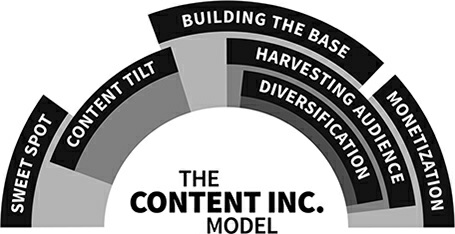Content Inc. By Joe Pulizzi
These are my personal book notes of Content Inc. by the author Joe Pulizzi.
Let’s dive in.
Facts
- Title: Content Inc.
- Subtitle: How Entrepreneurs Use Content To Build Massive Audiences And Create Radically Successful Businesses
- Author: Joe Pulizzi
- Author’s website: joepulizzi.com
- First published: 2015
- Type: non fiction
- Genre: online marketing
- Rating: 5/5
- Recommended: Yes (Hell, Yeah!)
Table Of Contents Of The Book
- Foreword By Brian Clark, Ceo, Copyblogger Media
- Introduction
- Part 1: Starting The Journey
- Chapter 1 - Beginning With The End In Mind
- Chapter 2 - The Content Inc. Opportunity
- Part 2: The Sweet Spot
- Chapter 3 - Knowledge Or Skill + Passion
- Chapter 4 - Adding Audience To Your Sweet Spot
- Part 3: The Content Tilt
- Chapter 5 - Understanding The Power Of The “Tilt”
- Chapter 6 - Discovering Your Content Mission
- Chapter 7 - Ways To Unearth Your Content Tilt
- Part 4: Building The Base
- Chapter 8 - Selecting Your Platform
- Chapter 9 - Content Ideation
- Chapter 10 - The Content Calendar
- Chapter 11 - Content Staffing
- Chapter 12 - The Collaborative Publishing Model
- Chapter 13 - Planning For Repurposing
- Part 5: Harvesting Audience
- Chapter 14 - The Metric That Drives The Model
- Chapter 15 - Building For Findability
- Chapter 16 - Stealing Audience
- Chapter 17 - Social Media Integration
- Part 6: Diversification
- Chapter 18 - The Three And Three Model
- Chapter 19 - Building Out Extensions
- Chapter 20 - Acquiring Content Assets
- Part 7: Monetization
- Chapter 21 - Waiting For Revenue
- Chapter 22 - Building The Revenue Model
- Part 8: Next-Level Content Inc.
- Chapter 23 - Putting It All Together
- Chapter 24 - Join The Movement
- Acknowledgments
- Appendix A: Cmi’S Contributor/Blogging Guidelines
- Appendix B: An Inside Look Into Cmi’S Publishing Process
- Index
Key Concepts & Ideas
Through a lovely accident, I stumbled on a powerful way to build a business in the digital age - and now believe there is no better way to go to market.
By focusing on building an audience first and defining products and services second, an entrepreneur can change the rules of the game and significantly increase the odds of financial and personal success.
Let me repeat that:
I believe the absolute best way to start a business today is not by launching a product, but by creating a system to attract and build an audience.
==> Like This 😉
Once a loyal audience is built, one that loves you and the information you send, you can, most likely, sell your audience anything you want.
This model is called Content Inc.
In the future, thousands of businesses around the globe will be leveraging a Content Inc. go-to-market strategy.
Why?
Because having a singular focus on audience, and building a loyal audience directly, gives you the best understanding of what products ultimately make the most sense to sell.
The Content Inc. Model
This is the model:

Let’s go through each part:
- The Sweet Spot - Simply put, the entrepreneur needs to uncover a content area that the business model will be based around. To make this happen, we need to identify a “sweet spot” that will attract an audience over time. This sweet spot is the intersection of a knowledge or skill set (something the entrepreneur or business has a competency in) and a passion area (something the entrepreneur or business feels is of great value to him or her personally or to society at large).
- Content Tilt - Once the sweet spot is identified, the entrepreneur needs to determine the “tilt,” or the differentiation factor, to find an area of little to no competition.
- Building the Base - Once the sweet spot is found and the tilt occurs, a platform is chosen and a content base is constructed. This is exactly like building a house. Before we get into all the paint and fixtures and flooring options, we have to plan and install the foundation. This is done by consistently generating valuable content through one key channel (a blog, a podcast, YouTube, etc.).
- Harvesting Audience - After the platform is chosen and the content base is built, the opportunity presents itself to increase the audience and convert “one-time readers” into ongoing subscribers. This is where we leverage social media as key distribution tools and take search engine optimization seriously. At this point, our job is not just to increase web traffic. By itself, web traffic is a meaningless metric. Our goal is to increase traffic to increase the opportunity to acquire an audience.
- Diversification - Once the model has built a strong, loyal, and growing audience, it’s time to diversify from the main content stream. Think of the model like an octopus, with each content channel being one of the eight arms. How many of those arms can we wrap our readers in to keep them close to us (and coming back for more)?
- Monetization - It’s time. You’ve identified your sweet spot. You’ve “tilted” to find an area of content noncompetition. You’ve selected the platform and built the base. You’ve started to build subscribers, and you’ve even begun to launch content on additional platforms. Now is when the model monetizes against the platform.
The key is following the six steps as outlined above and being patient enough for the model to work.
Entrepreneurship is the pursuit of opportunity without regard to resources currently controlled.
- Howard Stephenson
Putting It All Together
I’m going to ask you to go one step further:
Be patient.
There are only nine months between when I believed I was a complete failure and when I started something that looked to have the promise of success.
As I think back, it would have been so easy to give up and go find a “real” job.
I can’t even imagine that.
I love my career, the time I have with my family, the flexibility of my schedule, and how I wake up every morning inspired to work on a project.
If I hadn’t been patient, none of this would be possible right now.
I launched the business in April 2007.
It wasn’t until the end of 2010 that I felt we were on to something.
The next three years we made the Inc. 500 list of the fastest-growing private companies in the United States.
Today we have a $10 million business, and I’m still able to pick my kids up from school.
It wasn’t easy, but having patience made all this possible.
It takes time to build a loyal audience.
It takes time to find the right revenue model for your Content Inc. business.
But there is no doubt in my mind that this is the absolute best way to launch a business.
Yes, it’s different… some may say it’s strange… but it’s a better strategy than just hoping that a new product idea will take hold.
Be like David, who fought the urge to fight just like everyone else had against Goliath (and lost).
Take a different route and put the odds in your favor.
As you progress through this model, there will be moments where you feel the model isn’t working quite to your expectations.
That makes sense.
Content Inc., as a way of launching a business, is a new muscle for most people.
We’ve been used to communicating through mass media for so many years, and now we are trying to figure out how to deliver value to our customers outside of our products and services.
If you are struggling with your program, come back and review this chapter.
You may be struggling because of one of these reasons:
- Selfish content marketing. Create content that solves customers’ pain points. Stop talking about your products and services so much. If you do, make it about your customers.
- You stop. The biggest reason why content marketing fails is because it either stops or isn’t consistent. Remember, the content you deliver is like a promise to your customers. The biggest reason why the examples in this book succeeded was because the people never stopped producing amazing and compelling content.
- Activity instead of audience. Having people share and engage with your content here and there doesn’t mean much unless you are building an audience. One of the biggest mistakes companies make is not planning, in advance, to acquire an audience through content creation and distribution.
- No point of view. In order to position yourself as an expert in your industry, you need a point of view. Take a stance. Walking the fence is boring and, more importantly, usually doesn’t work.
- No process. I see it every day. Scenario: Marketing campaign… ads to be placed… then someone asks about the blog or white paper… people scurry about… someone runs out to get the content. Plan up front to create, repurpose, and distribute content.
- Where’s the call to action? Each piece of content should have a call to action or behavior you’d like to see. What would happen if you asked “why” to each piece of content you create? By doing this, you’ll be compelled to either know the call to action or kill the content (for lack of purpose).
- Channel silo. Are you paying attention to one channel at the expense of all the others? We want to have one main platform, like a blog, but you’ll miss the true power of content marketing by not leveraging all available channels as you expand your model. Think like a media company. The greatest media companies of all time focus on all three legs of the stool - digital content, print content, and in-person content.
- Forgetting employees. Employee expertise is the most underutilized content marketing asset. Your employees give your brand life. Leverage them in the creation and distribution process. Start with the 5 percent that get it. Show success stories and move on to the rest of your employee base. Tip: Don’t force your employees into a process they won’t do. Gather the raw content from employees however you can.
- One word: editing. Editing may be the most underrated piece of the content marketing process. Sometimes we as entrepreneurs don’t understand that the first draft of a piece of content is called a good start. Enter the editor. Get one or hire one.
Yes, there will be challenges.
There will be times that you’re not sure you are on the right path.
That is natural for any entrepreneur or small business owner.
But here’s the truth:
Until now, it was cost prohibitive for entrepreneurs to build a loyal audience.
Until now, the communication channels were not available.
Until now, the audience wasn’t willing to connect.
Until now.
By reading and following the Content Inc. method in this book, you have an opportunity to make a difference in your life, with your family, with your career path, and in the world.
My hope is that you seize that opportunity today and never look back.
Closing Thoughts
My book notes only cover small parts of the book.
So if you like what you read, please consider buying the book from the author.
Thank you for reading and stay awesome,
Tim for Online Business Dude
PS: Start Your Own, Profitable Online Business From Scratch, Step-by-Step, Today!
